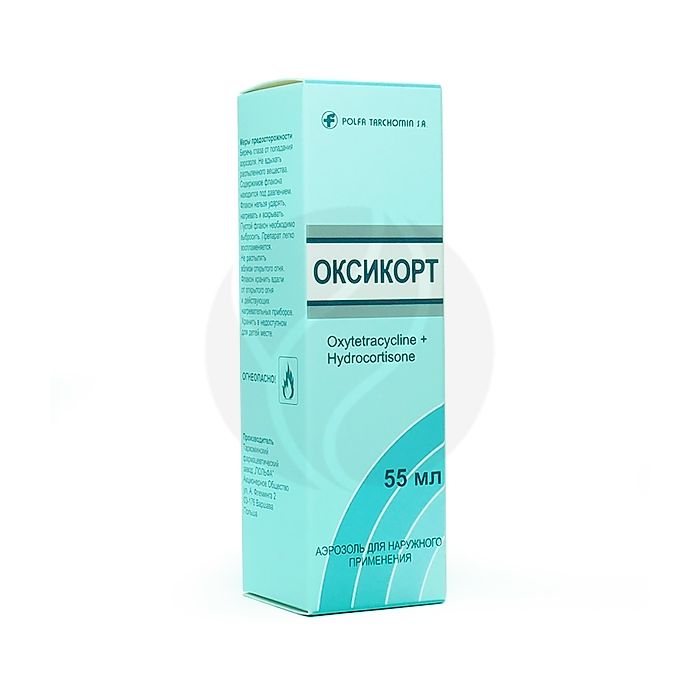Oxycort aerosol, 55ml
Russian Pharmacy name:
Оксикорт аэрозоль, 55мл
allergic skin diseases complicated by a secondary bacterial infection (urticaria, eczema);
skin diseases caused by microorganisms sensitive to oxytetracycline, as well as mixed infections (impetigo, furunculosis, folliculitis, multiple abscesses, erysipelas);
1st degree burns and frostbite;
secondary infections after insect bites.
Outwardly. Shake the bottle before use. The affected areas are irrigated with an aerosol stream for 3 seconds, holding the bottle in an upright position at a distance of about 15-20 cm from the skin surface. The procedure is carried out 2-4 times / day at regular intervals.
Aerosol for external use in the form of a homogeneous suspension from yellow to light brown color, without mechanical impurities, with a characteristic odor.
1 bottle
oxytetracycline hydrochloride 323.7 mg,?
which corresponds to the content of oxytetracycline 300 mg
hydrocortisone 100 mg
Excipients: sorbitan trioleate - 640 mg, lecithin - 4.87 mg, isopropyl myristate - up to 5.25 g, propellant (propane / butane / isobutane) - 27 g.
hypersensitivity to drug components;
lupus;
viral and fungal skin infections;
tumors and neoplasms of the skin.
pharmachologic effect
Oxycort is a drug for external use with a combined effect of two active ingredients.
Oxytetracycline is an antibiotic from the group of tetracyclines with a broad spectrum of action. Has a bacteriostatic effect on some gram-positive bacteria: streptococci; gram-negative bacteria: bacilli Enterobacteriaceae, Pseudomonadaceae, Pasteurellaceae (Haemophillus spp.), cocci (Neisseria spp.). Shows activity against microorganisms of the family Rickettsiaceae, Chlamydiaceae, Mycoplasma, Actinomyces, as well as some protozoa (Plasmodium, Entamoeba).
Hydrocortisone is a synthetic glucocorticosteroid of the adrenal cortex. It has anti-inflammatory, anti-allergic, antipruritic and anti-edema effects.
Pharmacokinetics
Oxytetracycline, when applied externally, is practically not absorbed into the bloodstream and has no systemic effect. Hydrocortisone can slightly enter the systemic circulation, is metabolized in the liver, and excreted by the kidneys.
Violation of the integrity of the skin, inflammatory and other pathological processes of the skin, occlusive dressing contribute to the absorption of the drug.
Side effect
Local reactions: burning, itching, irritation at the site of application of the drug, dryness and atrophy of the skin, acne-like rash, secondary infections. Long-term use of the drug on the skin of the face can lead to dilation of blood vessels, as well as to skin atrophy.
Development of systemic action is possible: inhibition of the hypothalamic-pituitary-adrenal system. These effects can occur with prolonged use of the drug and its application to a large surface of the skin.
Application during pregnancy and lactation
The use of the drug during pregnancy and lactation is contraindicated.
special instructions
In case of skin irritation, the drug must be canceled and appropriate measures must be started.
The use of oxytetracycline and other broad-spectrum antibiotics may lead to an increase in the number of resistant strains of staphylococci and Candida albicans. If an infection develops with resistant strains of bacteria or yeasts, appropriate treatment should be initiated.
The drug should not be applied to a large surface of the skin due to the possibility of the appearance of undesirable reactions characteristic of systemic steroid drugs, including suppression of the hypothalamic-pituitary-adrenal system (including symptoms of Cushing's syndrome, glucosuria). In these cases, it is necessary to interrupt treatment and control the level of cortisol in the urine.
Long-term use of the drug on the skin can lead to dilation of blood vessels and skin atrophy.
Protect your eyes from aerosol exposure. Do not inhale the sprayed drug. In case of contact with mucous membranes, rinse thoroughly with cool water.
The bottle must not be opened and heated, because the contents of the vial are under pressure and flammable.
Influence on the ability to drive vehicles and use mechanisms
The drug does not cause psychophysical disturbances, does not affect the ability to drive vehicles.
Overdose
Overdose symptoms were not observed with local application of the drug.
Drug interactions
When applied topically, the drug has not been established.

